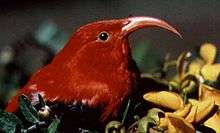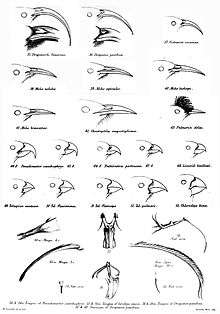Hawaiian honeycreeper
Hawaiian honeycreepers are small, passerine birds endemic to Hawaiʻi. They are closely related to the rosefinches in the genus Carpodacus. Their great morphological diversity is the result of adaptive radiation in an insular environment.[1][2]
| Hawaiian honeycreeper | |
|---|---|
 | |
| ʻIʻiwi (Drepanis coccinea) | |
| Scientific classification | |
| Kingdom: | Animalia |
| Phylum: | Chordata |
| Class: | Aves |
| Order: | Passeriformes |
| Family: | Fringillidae |
| Subfamily: | Carduelinae |
| Genera | |
|
See text | |
| Synonyms | |
|
Drepanididae | |

Before the introduction of molecular phylogenetic techniques, the relationship of the Hawaiian honeycreepers to other bird species was controversial. The honeycreepers were sometimes categorized as a family Drepanididae,[3] other authorities considered them a subfamily, Drepanidinae, of Fringillidae, the finch family. The entire group was also called "Drepanidini" in treatments where buntings and American sparrows (Passerellidae) are included in the finch family; this term is preferred for just one subgroup of the birds today.[4][5] Most recently, the entire group has been subsumed into the finch subfamily Carduelinae.[2][6]
Characteristics
Nearly all species of Hawaiian Honeycreepers have been noted as having a unique odor to their plumage, described by many researchers as "rather like that of old canvas tents".[7][8]
Today, the flowers of the native ʻōhiʻa (Metrosideros polymorpha) are favored by a number of nectarivorous honeycreepers. The wide range of bill shapes in this group, from thick, finch-like bills to slender, down-curved bills for probing flowers have arisen through adaptive radiation, where an ancestral finch has evolved to fill a large number of ecological niches. Some 20 species of Hawaiian honeycreeper have become extinct in the recent past, and many more in earlier times, following the arrival of humans who introduced non-native animals (ex: rats, pigs, goats, cows) and converted habitat for agriculture.[9][10]
Genera and species
The term "prehistoric" indicates species that became extinct between the initial human settlement of Hawaiʻi (i.e., from the late 1st millennium AD on) and European contact in 1778.
Subfamily Carduelinae
- Drepanidini
- Genus Aidemedia Olson & James, 1991 – straight thin bills, insectivores[11]
- Genus Akialoa Olson & James, 1995 – pointed, long and down-curved bills, insectivorous or nectarivorous
- Akialoa ellisiana Gray, 1859 – Oʻahu ʻakialoa (extinct, 1940)
- Akialoa lanaiensis Rothschild, 1893 – Maui Nui ʻakialoa (extinct, 1892)
- Akialoa stejnegeri Wilson, 1889 – Kauaʻi ʻakialoa (extinct, 1969)
- Akialoa obscura Cabanis, 1889 – lesser ʻakialoa (extinct, 1940)
- Akialoa upupirostris – hoopoe-billed ʻakialoa (prehistoric)
- Genus Chloridops Wilson, 1888 – thick-billed, hard seed (e.g. Myoporum sandwicense) specialist
- Chloridops kona Wilson, 1888 – Kona grosbeak (extinct, 1894)
- Chloridops regiskongi – King Kong grosbeak (prehistoric)
- Chloridops wahi – wahi grosbeak (prehistoric)
- Genus Chlorodrepanis Olson & James, 1995 – pointed bills, insectivorous and nectarivorous
- Chlorodrepanis stejnegeri Pratt, 1989 – Kauaʻi ʻamakihi
- Chlorodrepanis flava Bloxam, 1827 – Oʻahu ʻamakihi
- Chlorodrepanis virens Cabanis, 1851 – Hawaiʻi ʻamakihi
- Genus Ciridops Newton, 1892 – finch-like, fed on fruit of Pritchardia species
- Ciridops anna Dole, 1879 – ʻula-ʻai-hāwane (extinct, 1892 or 1937)
- Ciridops tenax Olson & James, 1991 stout-legged finch (prehistoric)
- Genus Drepanis Temminck, 1820 – down-curved bills, nectarivores
- Drepanis funerea Newton, 1894 – black mamo (extinct, 1907)
- Drepanis pacifica Gmelin, 1788 – Hawaiʻi mamo (extinct, 1898)
- Drepanis coccinea Forster, 1780 – ʻiʻiwi
- Genus Dysmorodrepanis Perkins, 1919 – pincer-like bill, possibly snail specialist
- Dysmorodrepanis munroi Perkins, 1919 – Lanaʻi hookbill (extinct, 1918)
- Genus Hemignathus Lichtenstein, 1839 – pointed or long and down-curved bills, insectivorous
- Hemignathus affinis – Maui nukupuʻu (extinct, 1995–1998)
- Hemignathus hanapepe – Kauaʻi nukupuʻu (extinct, 1998)
- Hemignathus lucidus – Oʻahu nukupuʻu (extinct, 1837)
- Hemignathus vorpalis James & Olson, 2003 – giant nukupu'u (prehistoric)[12]
- Hemignathus wilsoni Rothschild, 1893 – ʻakiapolaʻau
- Genus Himatione – thin-billed, nectarivorous
- Himatione sanguinea Gmelin, 1788 – ʻapapane
- Himatione fraithii – Laysan honeycreeper (extinct, 1923)
- Genus Loxioides Oustalet, 1877 – finch-like, Fabales seed specialists
- Genus Loxops – small pointed bills with the tips slightly crossed, insectivorous
- Loxops caeruleirostris Wilson, 1890 – ‘akeke‘e
- Loxops coccineus Gmelin, 1789 – Hawaiʻi ʻakepa
- Loxops ochraceus Rothschild, 1893 - Maui ʻakepa (extinct, 1988)
- Loxops wolstenholmei Rothschild, 1895 – Oʻahu ʻakepa (extinct, 1990s)
- Loxops mana Wilson, 1891 – Hawaiʻi creeper
- Genus Magumma - small pointed bills, insectivorous and nectarivorous
- Magumma parva Stejneger, 1887 - ʻanianiau
- Genus Melamprosops Casey & Jacobi, 1974 – short pointed bill, insectivorous and snail specialist
- Melamprosops phaeosoma Casey & Jacobi, 1974 – poʻouli (possibly extinct, November 28, 2004?)
- Genus Oreomystis Wilson, 1891 – short pointed bills, insectivorous
- Oreomystis bairdi Stejneger, 1887 – ʻakikiki
- Genus Orthiospiza – large weak bill, possibly soft seed or fruit specialist?
- Orthiospiza howarthi James & Olson, 1991 - highland finch (prehistoric)
- Genus Palmeria Rothschild, 1893 – thin-billed, nectarivorous, favors Metrosideros polymorpha
- Palmeria dolei Wilson, 1891 – ʻakohekohe
- Genus Paroreomyza – short pointed bills, insectivorous
- Paroreomyza maculata Cabanis, 1850 – Oʻahu ʻalauahio (possibly extinct, early 1990s?)
- Paroreomyza flammea (Wilson, 1889) – kākāwahie (extinct, 1963)
- Paroreomyza montana
- Paroreomyza montana montana Wilson, 1890 – Lana'i 'alauahio (extinct, 1937)
- Paroreomyza montana newtoni (Rothschild, 1893) – Maui ‘alauahio
- Genus Pseudonestor – parrot-like bill, probes wood for insect larvae
- Pseudonestor xanthophrys Rothschild, 1893 – Maui parrotbill or kiwikiu
- Genus Psittirostra – slightly hooked bill, Freycinetia arborea fruit specialist
- Psittirostra psittacea Gmelin, 1789 – ʻōʻū (probably extinct, 1998?)
- Genus Rhodacanthis – large-billed, granivorous, legume specialists[13]
- Rhodacanthis flaviceps Rothschild, 1892 – lesser koa-finch (extinct, 1891)
- Rhodacanthis forfex James & Olson, 2005 – scissor-billed koa-finch (prehistoric)
- Rhodacanthis litotes James & Olson, 2005 – primitive koa-finch (prehistoric)
- Rhodacanthis palmeri Rothschild, 1892 – greater koa-finch (extinct, 1896)
- Genus Telespiza Wilson, 1890 – finch-like, granivorous, opportunistic scavengers
- Telespiza cantans Wilson, 1890 – Laysan finch
- Telespiza persecutrix James & Olson, 1991 – Kauaʻi finch (prehistoric)
- Telespiza ultima Bryan, 1917 – Nihoa finch
- Telespiza ypsilon James & Olson, 1991 – Maui Nui finch (prehistoric)
- Genus Vangulifer – flat rounded bills, possibly caught flying insects
- Vangulifer mirandus – strange-billed finch (prehistoric)
- Vangulifer neophasis – thin-billed finch (prehistoric)
- Genus Viridonia
- Viridonia sagittirostris Rothschild, 1892 – greater ʻamakihi (extinct, 1901)
- Genus Xestospiza James & Oslon, 1991 – cone-shaped bills, possibly insectivorous
- Xestospiza conica James & Olson, 1991 – cone-billed finch (prehistoric)
- Xestospiza fastigialis James & Olson, 1991 – ridge-billed finch (prehistoric)
Hawaiian honeycreepers were formerly classified into three tribes – Hemignathini, Psittirostrini, and Drepanidini – but they are not currently classified as such.
See also
| Wikimedia Commons has media related to Drepanidinae. |
Cited references
- Lerner, H.R.L.; Meyer, M.; James, H.F.; Fleischer, R.C. (2011). "Multilocus resolution of phylogeny and timescale in the extant adaptive radiation of Hawaiian Honeycreepers". Current Biology. 21 (21): 1838–1844. doi:10.1016/j.cub.2011.09.039. PMID 22018543.
- Zuccon, Dario; Prŷs-Jones, Robert; Rasmussen, Pamela C.; Ericson, Per G.P. (2012). "The phylogenetic relationships and generic limits of finches (Fringillidae)" (PDF). Molecular Phylogenetics and Evolution. 62 (2): 581–596. doi:10.1016/j.ympev.2011.10.002. PMID 22023825.
- Clements, J. 2007. The Clements Checklist of the Birds of the World. 6th ed. ISBN 978-0-7136-8695-1
- Dickinson, E, ed. (2003). The Howard and Moore Complete Checklist of the Birds of the World (3rd ed.). Princeton University Press. ISBN 978-0-691-11701-0.
- AOU Check-list of North American Birds Accessed 26 December 2007
- Gill, Frank; Donsker, David (eds.). "Finches, euphonias". World Bird List Version 5.2. International Ornithologists' Union. Retrieved 5 June 2015.
- Pratt, H Douglas (2002). The Hawaiian Honeycreepers. Oxford University Press. p. 46. ISBN 978-0-19-854653-5.
- Pratt, H. Douglas (1992). "Is the Poo-uli a Hawaiian Honeycreeper (Drepanidinae)?" (PDF). The Condor. Cooper Ornithological Society. 94 (1): 172–180. doi:10.2307/1368806. JSTOR 1368806.
- Olson, Storrs L.; James, Helen F (1991). "Descriptions of Thirty-Two New Species of Birds from the Hawaiian Islands: Part I. Non-Passeriformes". Ornithological Monographs. 45 (45): 1–91. doi:10.2307/40166794. hdl:10088/1745. JSTOR 40166794.
- James, Helen F.; Olson, Storrs L (1991). "Descriptions of Thirty-Two New Species of Birds from the Hawaiian Islands: Part II. Passeriformes". Ornithological Monographs. 46 (46): 1–92. doi:10.2307/40166713. hdl:10088/1746. JSTOR 40166713.
- Beolens, Bo; Watkins, Michael; Grayson, Michael (2014). The Eponym Dictionary of Birds. Johns Hopkins University Press. ISBN 9781472905741. The genus Aidemedia is named in honor of Joan Aidem.
- James, Helen F; Storrs L. Olson (2003). "A giant new species of nukupuu (Fringillidae: Drepanidini: Hemignathus) from the island of Hawaii". The Auk. 120 (4): 970–981. doi:10.1642/0004-8038(2003)120[0970:AGNSON]2.0.CO;2.
- James, Helen F.; Johnathan P. Prince (May 2008). "Integration of palaeontological, historical, and geographical data on the extinction of koa-finches". Diversity & Distributions. 14 (3): 441–451. doi:10.1111/j.1472-4642.2007.00442.x.
Other references
- Groth, J. G. 1998. Molecular phylogeny of the cardueline finches and Hawaiian honeycreepers. Ostrich, 69: 401.
External links
- Hawaiian Honeycreepers (Drepanididae) information, including 4 species with videos and 11 with photographs at the Internet Bird Collection